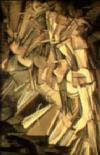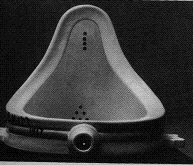Duchamp à Las Vegas
"In Las Vegas at the Golden Nugget, Marcel Duchamp moved the discussion from
the Monte Carlo sytem to the desire to ``perhaps win a little something.''
The most careful distinction was maintained between his interest (he touched
no equipment nor engaged directly into any game during the entire 48 hours),
and my unexpressed desire. He suggested that we might continue to sit
and chat, and from time to time he would suggest what I might do at
various of the three related tables.
His suggested opening seemed random. `` Place some chips on that table
and let's see what happens. '' After spins of the wheel - all chips lost -
what followed would be the first of, from time to time, repeated patterns
of ``let's relax and chat.'' I found things to talk about. He would
nod and smile and watch the table.
Then came the first move of a repeating play, alternating with the rests.
``Why don't you try seven chips on corners of the high numbers ?''
``Make diagonal pattens.'' ``Set them out diagonally.'' He
indicated that the arrangements should make diagonals to the grid of the
numbers. After the better part of an hour, during which time he became more
specific in his suggesting of each number to play, of what I remember as nine
chips at a time, what I realized was that I was indeed winning. Winning numbers
were coming up with increasing regularity. His moods seemed to change not
at all, wether I won or lost. I seem to recall, as the croupiers changed,
one may have interested him, as in terms of when to play, than the others.
One of the three tables seemed to interest him more than the rest, but I
can't be sure. One way or another there was no doubt in my mind about it
being HIS game. I did nothing but what he suggested and we stopped when he
said it was a nice time to stop.
The chips I had purchased (I recall $20 worth) were of the small denomination,
and my winning was more than 100-fold. The next day he gave me in an
envelope a signed casino reproduction of a roulette table, saying
``I thought you should have something for your trouble last night.''
Walter Hopps, october 1983 (as quoted in Yves Arman,
Marcel Duchamp. plays and wins. joue et gagne , Marval, Paris 1984).
A Bit More About Duchamp
"Rrose Sélavy et moi esquivons
les ecchymoses des Esquimaux aux mots exquis."
Marcel Duchamp (in Anemic Cinema )
Marcel Duchamp (Born Blainville, France 1887, Died Neuilly, France 1968) is
one of the major art figures of the twentieth century. His early
works are mainly paintings inspired by Cézanne and the Fauves. Around
1910 he starts to hang out with the "cubists" who he would often meet at his
brothers' house on sundays in Puteaux (just outside
of Paris). Many discussions revolved around the possibility of a "fourth
dimension" and how to represent it. In 1912 he paints his famous Nude
Descending a Staircase .

To his surprise it is refused at the "Salon des
Indépendants". In the following year he abandons painting and takes a job
at a library in Paris. There he continues his studies about the "fourth
dimension" which will eventually lead to "le grand verre" ("large
glass"). In the meantime his "Nude" causes a sensation in New York. In 1915
he arrives in New York and is greated as a celebrity. In the same year
he exhibits his first Readymades : buy something in a store and show
it in a gallery. His most famous Readymade is probably The Fountain :

From 1915 to 1923 he is mainly involved in the New York "Dada Movement" (with
his friend Man Ray). After 1923 Marcel Duchamp decides to devote his life to
chess and gambling, rather than making "art pieces". Also this period is
characterised by his famous "silence". Indeed Duchamp consciously refused
to comment about art and other issues. He has, however, given some rare
interviews in the US and France. Before he died he decided to surprise
us once more with his "latest work": Étant donnés: 1) La chute d'eau.
2) Le gaz d'éclairage. Duchamp stipulated
in his testament that no picture shall be taken of the work for at least
twenty years after his death. The piece is exhibited at the Museum of Modern
Art in Philadelphia. What could he possibly have created after more than forty
years of "silence" and "artistic inactivity"? Since more than twenty years
have passed since his death, you can now see Étant Donnés on the web at
http://www.val.net/~tim/etant-donnes.html
or locally
here
Some Quotes
I gleaned these from the following two books:
Duchamp, Duchamp du signe , Champs, Flammarion,
Paris 1975, and
Yves Arman, Marcel Duchamp. plays and wins. joue et
gagne , Marval, Paris 1984.
"Un tableau qui ne choque pas ne vaut pas la peine."
"Je me force à me contredire pour éviter de suivre mon goût."
"Art is produced by a succession of individuals expressing themselves;
it is not a question of progress. Progress is merely an enormous
pretension on our part."
"Readymade réciproque - se servir d'un Rembrandt comme planche à repasser."
"Puisque les tubes de peintures dont se sert l'artiste sont des produits
manufacturés, c'est-à-dire tout faits, nous
devons conclure que tous les tableaux du monde sont des Readymades aidés."
"Si tous les artistes ne sont pas des joueurs d'échecs, tous les
joueurs d'échecs sont des artistes."
"Peut-on faire des oeuvres qui ne soit pas ``d'art''?"
"Pour moi il y a quelque chose de plus que oui, non, ou
indifférent - c'est - par exemple -
l'abscence d'investigations de ce genre."
"I have not stopped painting. Every picture has to exist in the mind
before it is put on canvas, and it always loses something when it is turned
into paint. I prefer to see my pictures without that muddying."
"A guest + a host = a ghost."
"There is no solution because there is no problem."
"En réalité, les problèmes les plus profonds ne sont pas des problèmes du
tout, puisque : La solution du problème de la vie s'entrevoit dans la
dispparition de ce problème."
"Chaque mot que je vous dis est stupide et faux."
In preparation: "Duchamp on Rendering".


